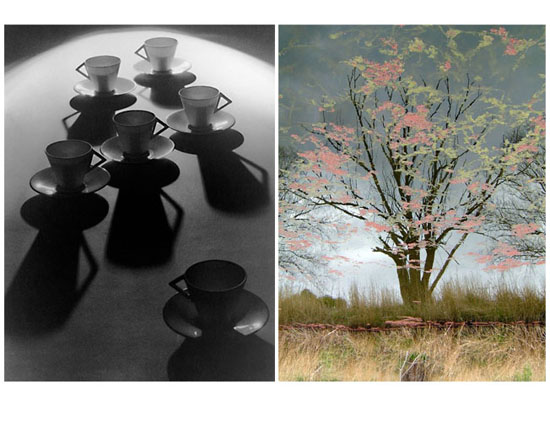Stella Rosa McDonald talks with artist Sally McInerney about Mother and Daughter, an exhibition of her photography alongside work by her late mother, Olive Cotton…
There is a spirit of unselfconscious, uninterrupted and almost artless art-making in the photographs of Olive Cotton and her daughter Sally McInerney, exhibited together for the first time in Mother and Daughter at Damien Minton Gallery. The exhibition includes over forty photographs from the two photographers that communicate their shared understanding of shadows and light, the natural world and family.
In the middle of the room sit two glass vitrines filled with what would, in the vernacular of most families, be called pictures. There are pictures of dogs and children with cameras, pictures of flowers and seasons changing, pictures of friends and family over three generations. But these don’t look like the pictures of my family; they are pictures you want look at for longer, not shuffle through quickly to get to the bottom of the pile. These pictures emit a sense of natural grace that brings the incidental things they depict from ubiquity into the realm of art.
The photographic archive that sits between the works of the two photographers spells out the pictorial and familial relationship between mother and daughter, but it also hints at the innate role photography played in their family through the generations. This is a family where there is no difference between a picture and a photograph, between a snapshot and art.
The photographs by Cotton and McInerney in the exhibition proper are difficult to talk about without making them sound like purely idyllic or ornamental scenes. They are simply, beautifully, everyday objects and encounters made stark by shadow and light. But it is in talking with McInerney about the lives that shaped the images that the exhibition itself gathers weight.
“Olive taught me about photography, but only in a sort of conversational way. And Ross’ family (her father Ross McInerney) was unusual, there were seven children and they all had Box Brownie cameras. It was regarded as a good thing to do and good to have a camera in the house in case you needed to use it.” Her father introduced Olive to photography after he returned from a trip to the Antarctic with Shackleton in 1907. There is a delicate photograph in the exhibition taken by Olive, aged ten, of gum blossom in a glass vase. The image is astounding because of its relationship to the still life’s Cotton made in adulthood, and its echo’s can be found in many of her images including Shasta Daisies (1937). “When she arranged flowers she didn’t just stuff them into a vase, she arranged them very formally. Formal in the sense that they were arranged to show the flowers in a way that didn’t take away their independence.”
As a family living at Koorawatha, just outside Cowra, they had a habit of sharing natural wonders like perforated gum leaves and interesting clouds with each other, and these objects appear as motifs in photographs like Skelton leaf and Vapour Trail by Cotton and Cloud Road at Coomingla and Lichen Tree by McInerney. “I always felt, since I was a kid, that mine and Olive’s photography was very different,” McInerney says. Her images are not staged or studio set-ups, like many of Cotton’s were, but her landscapes share the same sense of artful discrimination that gives shade to Cotton’s oeuvre. It is a shared capacity to refine, rather than add to the image that connects the two photographers. “I realised (in making this exhibition) that Olive and I did often refer to things like flowers, especially daisies, which have great variations. There’s a form and informality about daisies, they’re not stiff, rigid florally things.”
McInerney has plans for the landscape and talks passionately about the photos she’s yet to take; there’s an abandoned building site in Glebe where trees have begun to grow in the foundations, she also needs to get to the farm in Cowra to photograph their old water tank, which is on the verge of toppling over. In a newspaper article with the headline “Artist Discusses A Hobby For Women,” a young Olive Cotton discusses her approach to Photography. “One thing that women who wish to become good photographers should remember is that the camera can do more than merely record an unchanging picture of a subject. A landscape, for instance, is there for everyone to photograph – an apparently changeless combination of earth, and trees, and grass; but it can be photographed in a hundred different ways…and this is where discernment and personality coming to the picture, as it were.” Despite the tenor of the era, it could be McInerney talking.
Between mother and daughter there is obviously a shared sense of subject matter; some photographs in the exhibition appear as reflections of each other, with their likeness warped only by the change from Cotton’s black and white film to McInerney’s digital colour prints. But there are some similarities between the two photographers that seem to be the result of mechanics as much as influence. At the far end of the exhibition are two small photos. In one the shadow of the photographer shades the face of a man lying in the sun. In the other, the photographer’s shadow is outlined against a moss covered, corrugated wall. In both photos the shadows are elegant, the elbows poke out from the hips and the heads are bowed in the tell tale pose of a photographer using a Rolleiflex camera. One is Cotton’s and the other is McInerney’s, made decades apart.
Olive Cotton & Sally McInerney, Mother and Daughter: A Conversation
Damien Minton Gallery, until May 24.


This is a beautifully written piece. I find it wonderful and important that a journalist made the time to slow down and consider this very special story with such depth. Thank you to the writer, Stella Rosa McDonald.